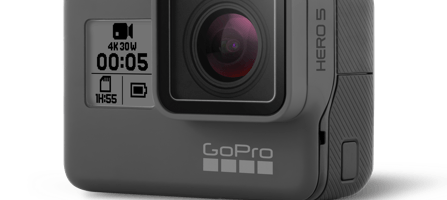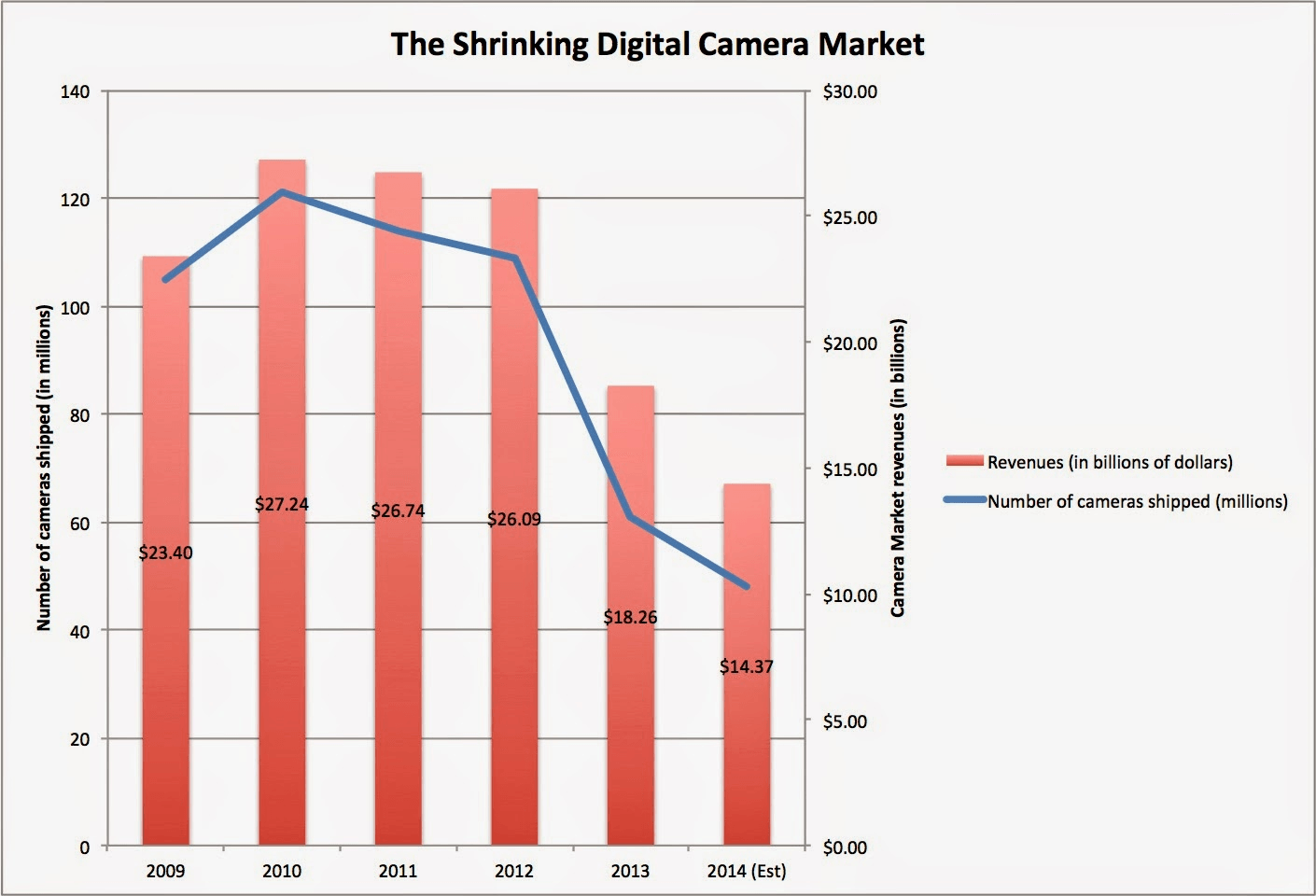GoPro: The Defiance of the Smartphone Era

After thriving in the 90’s, in 2001, Kodak’s sales were dropping as a symptom of the near end of the analog cameras era. That same year, Nick Woodman developed the first “GoPro” prototypes.
As we reflect on the technological advances that were made in the 2000’s, it is safe to say that the first decade of the 21st century came with the demise of some industries, including the analog cameras one. First, digital cameras took over the landscape with its digitalization of images. The fast dethroning did not secure the realm for long as it transitioned very quickly into the rise of smartphones, which provided the consumer the possibility of having all-in-one products. In 2009, Apple improved its winning iPhone and released the first ever iPhone with video. At this moment, the growing digital camera industry came to a halt and quickly lost popularity. But not everyone was losing, in fact, GoPro was just starting.
Source: CIPA.
The adventurous camera giant, who was valued at ~US$3bn at its IPO[1], has been defying the smartphone industry ever since. Since its inception, the company’s business model was purposely aimed towards a niche target market: the adventurous. Enclosed in a 2×3 inch camera, the user has access to HD Video (1080 P video at 127° wide-angle; now 4K) and up to 12 megapixel photos[2] that surpass the quality of any smartphone. As GoPro’s name suggests, the company’s value proposition is focused on delivering professional quality images for on-the-go adventure takers in a way no other camera can. As the company’s first hire, Neil Dana[3], smartly pointed out “when we started getting into HD that’s when we realized that this could be absolutely massive.” Emphasizing on technical specs, GoPro’s business model offers extreme features that combined with functional add-ins the consumer is invited to explore, dare, and go further, while having it recorded on camera.
The company’s operating model has been driven by a mixture of the old-fashioned ways and the new incoming trends. By being a camera company, GoPro heavily relies on retail sales and approaching the consumer through traditional channels. In order have a full GoPro experience, the consumer needs to purchase accessories that allow the use of the camera in extreme situations such as going under water, jumping off from a plane or heli-skiing. As part of their model, the company offers a 30-day money back guarantee to assure customer satisfaction. To maintain the value added, the company invests ~US$30 million[4] in research and development every year to improve the amazing quality inside the tiny camera. Now, models have integrated technological features such as auto-upload to the cloud, GPS and voice control. These advances allow the company to keep up to the tensions that the smartphone industry presents.
Source: GoPro.
But GoPro is much more than manufacturing and selling cameras in stores, GoPro has learned to leverage the technological and socially dynamic environment in which we live nowadays. GoPro’s use of social networks has been key to the company’s superb operational execution. By engaging consumers in globally sharing their videos and experiences, adventurers are encouraged to record all their experiences and then present them to the world as a token of achievement. By joining the GoPro community, the customer can access a library of content and can download apps that allow saving, editing and sharing content. These actions are part of GoPro’s initiatives to vertically integrate and take the experience beyond the image capturing. GoPro is changing the ways athletes do sports, pilots fly planes, travelers discover, and entertainers attract.
As the smartphone industry keeps growing, it will be very difficult for GoPro to keep up their competitive advantage and defend their place in the market. Smartphones will begin to integrate more features that allow their use in extreme and adventurous settings with the advantage of being an all-in-one product. This year (2016), Apple introduced the first waterproof iPhone[5], which is only the beginning of so many possible additions to come. GoPro’s preparedness for the future is key and must be very aggressive to help the company survive. Developing hardware and software that can integrate with smartphone companies might be a way to mitigate the risk. Offering knowhow and quality, GoPro can become a provider for the all-in-one products. The camera industry has proved to be fast changing; will GoPro defy this trend? Or will the company succumb and mimic Kodak’s faith into disappearance? We will learn soon rather than later.
Word Count: 757 words
[1] Leslie Parker, “GoPro Jumps After IPO Values Camera Maker at $3 Billion” Bloomberg Technology (June 2014)
[2] “Form S-1 Registration Statement GOPRO, INC.” (May 2014), p.11
[3] “GoPro Evolution from 35mm Film to America’s Fastest Growing Camera Company” Forbes (2013)
[4] “Form S-1 Registration Statement GOPRO, INC.” (May 2014), p.11
[5] “Apple Introduces iPhone 7 & iPhone 7 Plus —The Best, Most Advanced iPhone Ever” Apple Newsroom (September 2016)






Great stuff. I wonder if GoPro will succeed not by staving off disruption from smartphones, but by forcing its own disruption on the legacy handheld camera market. The 4K video quality offered by the GoPro model mentioned above approaches the capabilities of far more expensive and larger equipment.
On a recent vacation I pulled out my Sony DSLR to take a picture. Multiple HBS classmates expressed surprise that I owned a “real” camera!
Amazing how GoPro has managed to stay relevant given the fate of digital cameras, especially given their seemingly small target market. But given the rapid development of the video capabilities of smartphones, I’m very concerned that GoPro won’t be able to maintain their position as the go-to camera for adventure seekers. Perhaps the best way for GoPro to differentiate itself is to provide easy to use video editing.
Great article!
As a big fan of GoPro, I must confess that this was a pleasurable reading!
GoPro changed the way we deal with cameras: I carry my GroPro whenever I go adventure. Small, practical and reliable.
As you have mentioned in the text, it is changing the way athletes, travelers, etc are image capturing, and this is amazing.
Unfortunately, there will be some tough challenges. As you have mentioned, as smartphone industry begins to flourish and tech companies start to heavily invest in mobile’s camera updates, it will be tough for GoPro to stay with its competitive advantage.
Recently, the company is investing in new products, such as drones. Honestly, I think GoPro just realized what you have mentioned and is desperate to avoid what happened with Kodak.
Great article!
I agree with you – the biggest challenge GoPro will face now is the competition from mobile phones cameras.
As companies like Apple and Samsumg start developing phones and accessories with similar functionalities to the GoPro (e.g. water-proof, fish-eye lenses), I don’t see how the company could survive. Something to consider would be how to partner with one of these providers to actually create a camera / accessory that could be use along with the hand device.
Great post! When GoPro was introduced, it disrupted the industry and many digital camera companies (Panasonic, Nikon, Sony, etc.) suffered market share losses. GoPro changed the way customers use cameras but now it faces a new competition with mobile phone cameras (Apple iPhones in particular, as you mentioned). It will be interesting how GoPro changes its product line and customer offerings in the future to continue to stay ahead in the industry.
I think a big reason why GoPro has been successful, more than the technology, is it’s brand. It has successfully positioned itself as the go to camera for extreme athletes, travelers, and water sports enthusiasts for its extreme durability and simplicity of use. Many of these people appreciate that they can just bring those GoPros and record videos while doing these extreme activities without the fear of it breaking or its screen being shattered. Furthermore, they don’t want to fiddle with many complex features since most of the things they want to capture are instantaneous on the spot moments that need quick capture times.
In this regard, GoPro has positioned itself as a niche product and it will be very difficult to move out of it to go to mainstream. That said I still think cellphone manufacturers have a lot of work to do if they want to capture these particular users and their in the moment photo and video opportunities.
Thanks for sharing your thoughts on GoPro. As a user of GoPro, I love the high-quality images and videos it provide. However I think that the initial hype for GoPro has led too many everyday consumers (like myself) to purchase the devise and ended up only using it a few times a year during vacation. And not even all the vacations, but only the ones that involve physical activities. I have stopped using my GoPro since last year merely because I did not do any adventurous travel. The financial market has acknowledged such limitation on usage scenario – at its peak, GoPro stock price reached $87 (~$12bn market cap) but is now only worth $10 (~$1.4bn market cap), and the analyst community has consensus negative views on the future of the company.